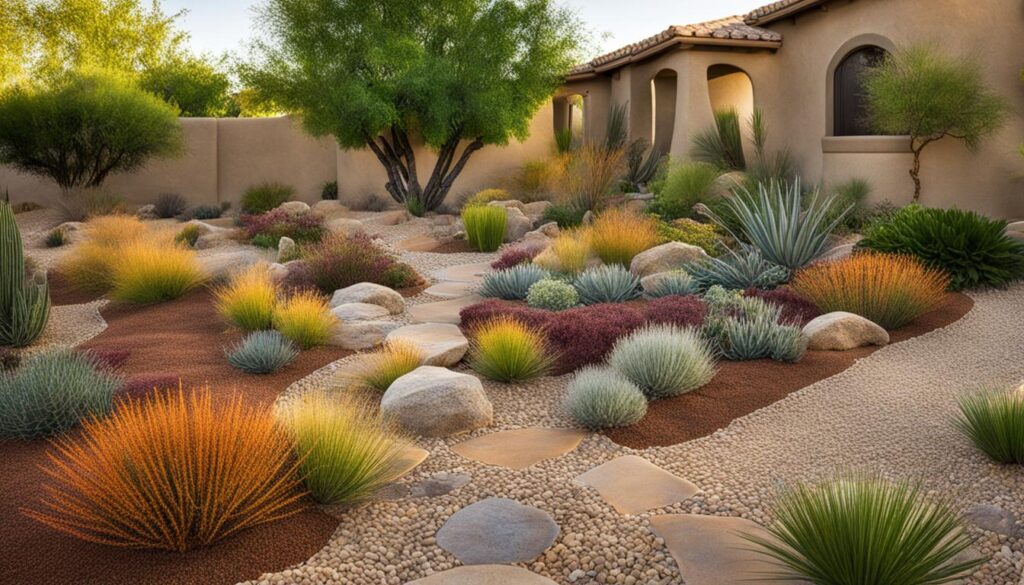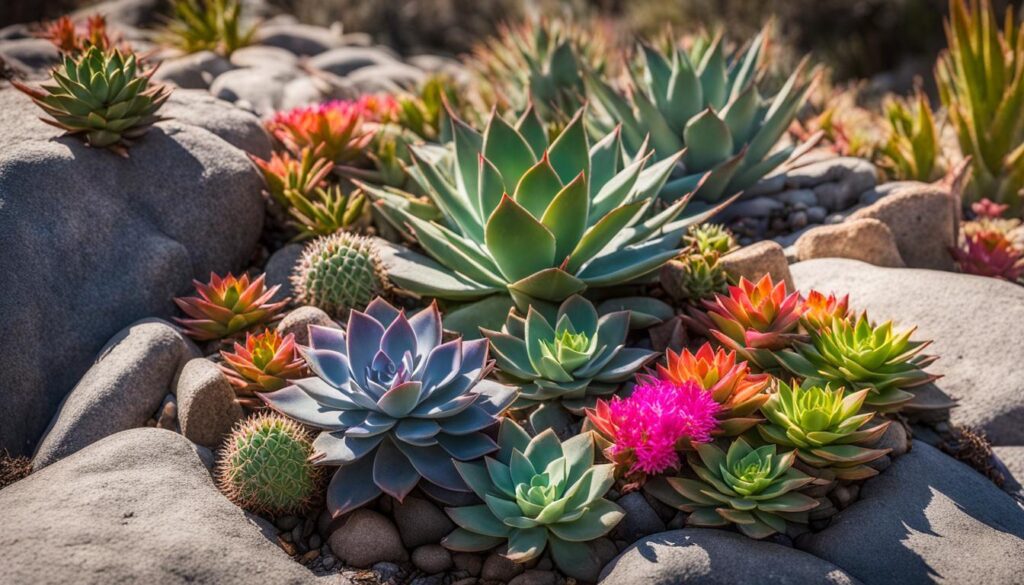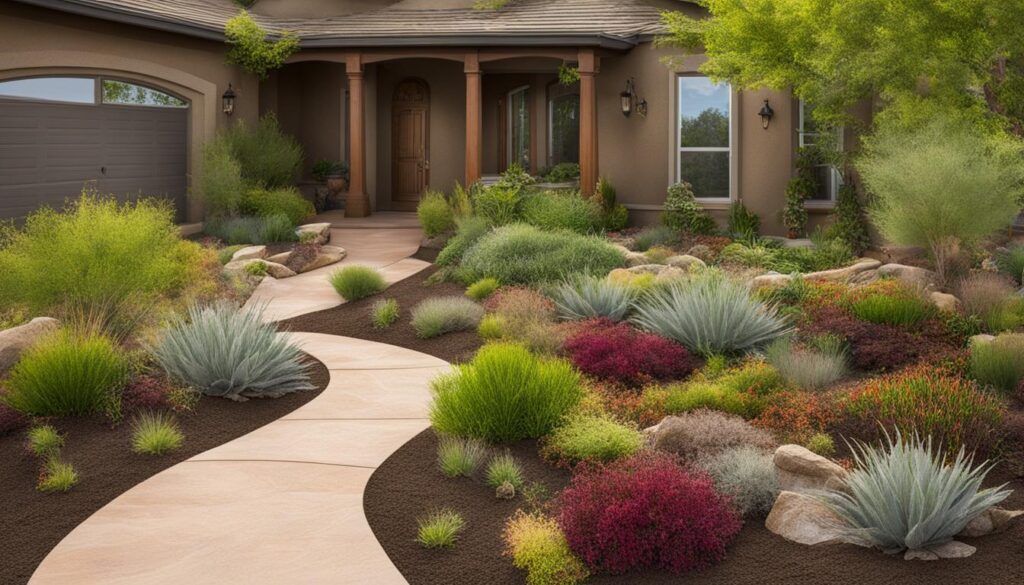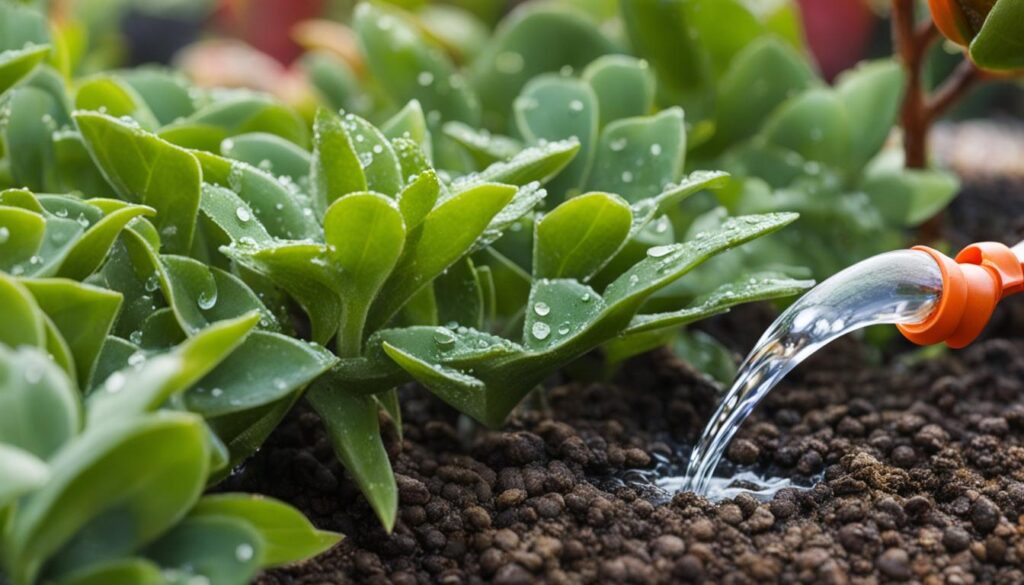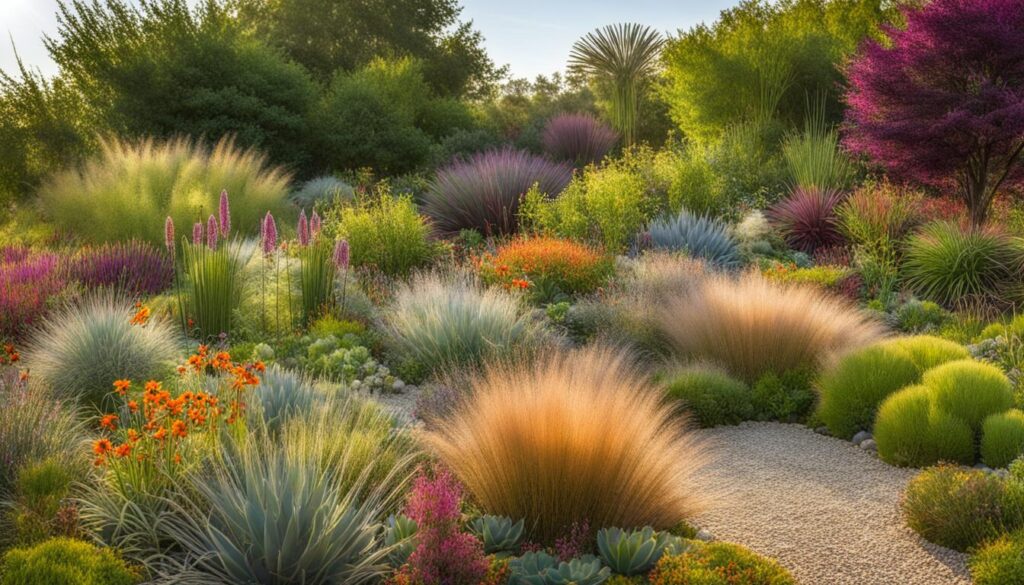Xeriscaping is a sustainable landscaping practice that reduces the need for irrigation. By incorporating elements such as potted and drought-tolerant plants, local natives, and utilizing water-saving techniques, you can create a beautiful and low-water garden. Planning and design, soil improvement, appropriate plant selection, efficient irrigation, and the use of mulch are all key principles of xeriscaping. It’s important to maintain your landscape and consider alternative options to traditional turf grass. With xeriscaping, you can save water, time, and create a sustainable outdoor space.
Key Takeaways:
- Implement xeriscaping to reduce the need for irrigation in your garden.
- Incorporate potted and drought-tolerant plants, local natives, and water-saving techniques into your design.
- Consider the principles of planning and design, soil improvement, appropriate plant selection, efficient irrigation, and the use of mulch.
- Maintain your landscape and explore alternative options to traditional turf grass.
- Create a sustainable outdoor space that saves water and time.
Continue reading to discover the seven principles of xeriscaping and how to plan, choose appropriate plants, maximize soil improvement, implement efficient irrigation techniques, and explore turf grass alternatives.
The 7 Principles of Xeriscaping
Xeriscaping is a sustainable landscaping practice that incorporates seven key principles to create a low-water garden. By following these principles, you can design a beautiful and water-efficient outdoor space.
1. Planning and Design
The first principle of xeriscaping involves careful planning and design. You should create zones within your garden based on the water requirements of different plants. Sketching out your space and visualizing the design can help you achieve the desired outcome.
2. Soil Improvement
Improving the soil is crucial for moisture retention in a xeriscape garden. Adding organic matter such as compost and incorporating soil amendments can help enhance soil quality, allowing it to better retain water for the plants.
3. Appropriate Plant Selection
Choosing the right plants is essential in xeriscaping. Opt for native plants and drought-tolerant species that are well-suited to your climate and require minimal watering. By selecting appropriate plants, you can ensure they thrive in low-water conditions.
4. Hydrozoning
Hydrozoning involves grouping plants according to their water needs. By creating zones with plants that have similar watering requirements, you can ensure efficient water use and prevent over- or under-watering.
5. Efficient Irrigation
Xeriscaping promotes efficient irrigation practices. Instead of traditional sprinkler systems, consider using drip irrigation, which delivers water directly to the plant’s root system. This not only minimizes water waste but also helps build healthier root systems.
6. Turf Grass Alternatives
Reducing the use of turf grass is an important part of xeriscaping. Consider alternative options such as patios, decks, mulches, and gravel to replace areas traditionally covered with grass. This helps conserve water and creates a more sustainable landscape.
7. Mulching
Applying mulch is an effective way to retain moisture in the soil and prevent weed growth. Organic mulches, such as wood chips or straw, can help regulate soil temperature and conserve water, reducing the need for frequent watering.
By implementing these principles in your xeriscape garden, you can create a visually appealing landscape that conserves water and promotes sustainability.
Planning and Design with Xeriscaping
When it comes to creating a water-saving landscape, proper planning and design are essential. By carefully considering the unique characteristics of your space, you can create a xeriscape garden that not only conserves water but also enhances the beauty of your outdoor space.
The first step in the planning process is to evaluate the topography, exposure, and soil of your site. This will help you understand the specific needs and challenges of your space so that you can make informed decisions about plant selection and placement.
“The key to successful xeriscaping lies in creating planting zones based on water requirements and grouping plants accordingly.”
One important technique to consider is hydrozoning. This involves grouping plants based on their water needs and creating zones from highest to lowest water use. By doing so, you ensure that each plant receives the right amount of water, reducing waste and maximizing efficiency.
Sketching and Zoning
Sketching a rough draft of your space and zoning it can help you visualize the design and ensure that water-saving techniques are implemented as intended. Use your sketch to map out the different zones and determine where each plant will be placed. This will give you a clear plan to follow during the implementation phase.
By investing time and effort in the planning and design phase of your xeriscape garden, you set yourself up for success. You can create a beautiful, water-efficient landscape that not only saves you time and money but also contributes to a more sustainable environment.
Choosing Appropriate Plants for Xeriscaping
When it comes to xeriscaping, selecting the right plants is crucial for the success of your low-water garden. By choosing plants that are native to your region or are drought-tolerant, you can ensure they are well-suited for the low-water conditions of xeriscaping. Native plants, in particular, are adapted to the local climate, requiring less water and maintenance.
Consider the water and sun needs of your plants when making your selections. Opt for a mix of aesthetic plants that provide a variety of heights, colors, and bloom times. This will not only add visual interest to your garden but also create a more vibrant and dynamic landscape. Remember, xeriscaping doesn’t mean sacrificing beauty; it’s about designing with intention and sustainability.
When choosing plants for xeriscaping, keep in mind that some plants may require more care initially to establish a healthy root system. However, once established, they will thrive in your low-water garden. By focusing on selecting appropriate plants, you can ensure a flourishing and sustainable landscape that conserves water and reduces maintenance.
Maximizing Soil Improvement in Xeriscaping
In xeriscaping, soil improvement plays a crucial role in creating an optimal growing environment for your low-water plants. By maximizing moisture retention and enhancing soil quality, you can ensure the success and sustainability of your xeriscape garden.
One effective way to improve soil in xeriscaping is by incorporating organic matter such as compost and manure. Adding these natural materials to your soil helps increase its water-holding capacity and nutrients, promoting healthy plant growth. Organic matter also improves the overall structure of the soil, allowing for better root development and reducing the risk of erosion.
When selecting soil amendments for xeriscaping, it’s important to consider the specific needs of your plants. While some plants thrive in soil with higher organic matter content, others, especially native plants, require less organic matter. By tailoring your soil amendments to the requirements of your chosen plants, you can ensure a harmonious and sustainable ecosystem in your xeriscape garden.
Benefits of Maximizing Soil Improvement:
- Enhanced moisture retention, reducing the need for frequent watering
- Promotion of healthy root development and plant growth
- Improved soil structure, reducing the risk of erosion
- Nutrient-rich environment for plants to thrive
- Sustainable and eco-friendly gardening practices
“By focusing on soil improvement, you can create an optimal growing environment for your low-water plants.”
Key Tips for Maximizing Soil Improvement:
- Add organic matter such as compost or well-rotted manure to your soil regularly.
- Ensure the type and amount of organic matter align with the specific needs of your plants.
- Consider the water requirements of your plants and tailor your soil amendments accordingly.
- Regularly monitor the moisture levels in your soil to maintain an optimal balance.
- Implement erosion control methods such as terracing or mulching to protect your soil.
By prioritizing soil improvement in your xeriscape garden, you can create a thriving and sustainable landscape that conserves water and supports healthy plant growth.
Efficient Irrigation in Xeriscaping
Efficient irrigation is a crucial aspect of xeriscaping, ensuring that your low-water garden receives the right amount of water without waste. One effective method of irrigation in xeriscaping is drip irrigation. Drip irrigation systems deliver water directly to the root zone of plants, minimizing water loss through evaporation and ensuring that plants receive the moisture they need. By targeting the root system, drip irrigation helps build healthy root systems, promoting stronger and more resilient plants.
When using drip irrigation, it’s important to water deeply and infrequently. This allows the water to penetrate the soil and encourages plants to develop deep root systems, which can access water stored in lower soil layers. By watering deeply, you also reduce the frequency of irrigation, conserving water and promoting water efficiency.
Another benefit of efficient irrigation in xeriscaping is the reduction of water runoff. Drip irrigation delivers water slowly and directly to the plants, preventing excess water from running off the landscape and being wasted. This not only saves water but also helps protect your garden from erosion and nutrient loss.
Building Healthy Root Systems
Efficient irrigation plays a key role in building healthy root systems in your xeriscape garden. By providing water directly to the root zone, you encourage plants to develop deep and extensive root systems. Deep roots help plants withstand drought conditions by accessing water stored in deeper soil layers. They also improve nutrient uptake and overall plant health, leading to stronger and more vibrant plants in your low-water garden.
How Can Xeriscaping Help with Low-Water Garden Design?
Master xeriscaping for garden design can greatly reduce water usage and maintenance needs. By utilizing drought-tolerant plants, soil improvement techniques, and efficient irrigation methods, xeriscaping can create a beautiful and sustainable low-water garden. With thoughtful planning and strategic plant selection, xeriscaping can help conserve water and promote ecological balance.
Turf Grass Alternatives in Xeriscaping
If you’re looking to create a low-water garden and reduce water usage, it’s essential to consider turf grass alternatives in your xeriscaping design. Traditional grass lawns require a significant amount of water, especially during low-water cycles or droughts. By exploring alternative options, you can not only conserve water but also beautify your yard in unique and sustainable ways.
One popular alternative to turf grass is to downsize lawn areas and incorporate features such as patios and decks. These hardscape elements can provide functional outdoor spaces for entertaining and relaxing while reducing the amount of water needed for a large grassy area. Additionally, patios and decks can be designed using permeable materials, allowing rainwater to infiltrate the soil instead of running off into storm drains.
Another effective way to replace turf grass is to utilize mulches and gravel in your xeriscape design. Mulches, such as wood chips or bark, not only help retain moisture in the soil but also suppress weed growth. Gravel, on the other hand, provides a low-maintenance and drought-tolerant ground cover that can give your yard a modern and contemporary look. Both options require minimal water and maintenance, making them ideal for a low-water garden.
By considering turf grass alternatives in your xeriscaping project, you can create a visually appealing and sustainable landscape that requires less water and maintenance. Whether you choose to incorporate patios and decks, mulches, or gravel, these alternative options will not only reduce water usage but also add unique textures and visual interest to your yard. Embrace the beauty and practicality of turf grass alternatives in xeriscaping and create a low-water garden that thrives with minimal environmental impact.
Conclusion
Xeriscaping offers a practical and sustainable solution for low-water garden design. By implementing the principles of xeriscaping, you can create a visually appealing and water-efficient landscape that contributes to the greater goal of sustainable landscaping.
With xeriscaping, you have the power to conserve water while still enjoying a beautiful outdoor space. By carefully planning and designing your garden, improving the soil, selecting appropriate plants, and using efficient irrigation methods, you can minimize water usage and create a more environmentally friendly landscape.
Embracing xeriscaping not only saves water but also reduces maintenance requirements in the long run. By incorporating low-water cycles and exploring alternatives to turf grass, such as patios, decks, mulches, and gravel, you can transform your yard into a sustainable oasis.
Join the movement towards sustainable landscaping today and discover the benefits of xeriscaping. With its focus on water conservation and low-water garden design, xeriscaping allows you to create a beautiful outdoor space that is both visually appealing and environmentally responsible.






